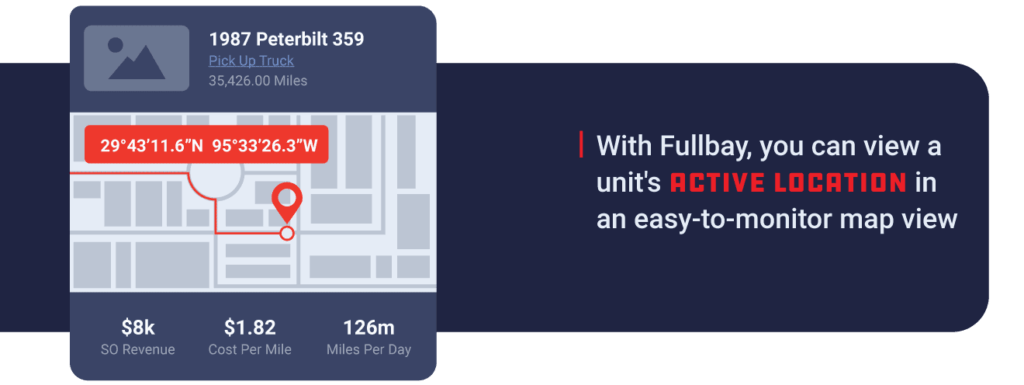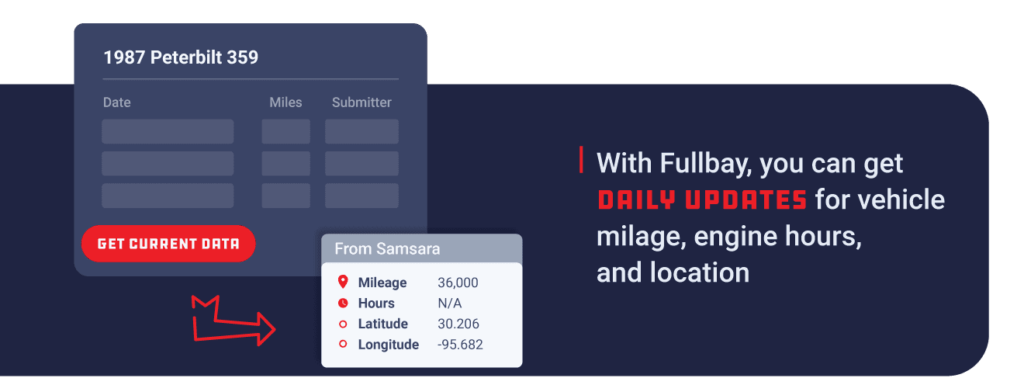Telematics: How Fullbay’s GPS Integration Can Help Your Shop

Welcome to the twenty-first century! Are you putting telematics to work for your fleet yet?
Because you probably should be.
If even reading the word telematics made you pause, then let us reassure you: We’re not here to provide a big dissertation on technology, as fun as that would be for everyone. Instead, we’re going to discuss what fleet telematics are to the heavy-duty industry, and how a repair shop can use them to provide better service, improve customer retention, and generally increase revenue.

WHAT IS FLEET TELEMATICS?
Telematics is what happens when you cross information processing with telecommunications. Basically, you’re using telecommunications equipment to send data about a vehicle. For the purposes of this article and our industry, telematics refers to:
- GPS
- Built-in hands-free features for mobile phones
- Emergency warning systems and wireless safety communications
- Automatic assistance and self-driving systems
Okay, Fullbay, you’re saying, but how does it work?
At its most basic level, you can jump on the telematics train by plugging a telematics device
into the vehicle in question. The full features lineup will depend on what kind of device you’re using and what service you’re hooked up to, but some of the big things truck telematics can track include:
- Mileage
- Engine hours
- Truck location
Other types of telematics can also track engine temperature and even seatbelt usage.
HOW TELEMATICS CAN POWER A HEALTHIER FLEET
Preventive maintenance often comes down to math and data. Suggested maintenance times are usually based on a manufacturer’s guidelines: when is this part due to wear out? How many engine hours is this part good for?
Telematics, as we pointed out above, can track some of these details with astonishing accuracy.
Maintaining vehicles while sticking to timelines and budgets can often turn into something of a balancing act for fleet managers. They know a truck will need maintenance soon, but they also really need it out on the road, earning its keep. If they’re tracking mileage and hours the old way—by hand—then there’s a lot of guesswork involved. Should they pull it off the road for maintenance, or wait and chance a breakdown?

You can see where we’re going with this. By adding a telematic device to your truck or fleet, a fleet manager can see exactly how many engine hours a vehicle has logged, or how many miles they’ve driven since their last maintenance. With this kind of information at hand, a fleet manager can see exactly when it’s time for a truck to go in for service, and your shop can make its PM work even more accurate.
Accurate PM work means happy customers. Happy customers are usually repeat customers and often turn out to be pretty awesome word-of-mouth marketers.
HOW TO PUT TELEMATICS TO WORK FOR YOU
But Fullbay, you may be saying, how do I pitch this?
For the Shop: If you’re patched into a vehicle’s telematics, you’re cutting out the time-consuming step of manually updating certain information each time it arrives.
Pretty enticing, right? If you’re a busy repair shop, you’re always looking for ways to improve the services you provide to your customers, but you may not be sure how. The odds are you’re operating on thin time margins as it is, and every moment your techs spend entering information manually (or digging that information up to enter it manually) is a moment away from actually working on a vehicle. That can add up to significant shop downtime.
But as we mentioned above, telematics doesn’t just apply to a truck rolling up to a repair shop. This data also keeps you up to date on how a vehicle that hasn’t been in the shop for a while is doing. You’ll know when to call a customer to remind them it’s time for PM work, and you’ll have all the vehicle’s operational information at your fingertips when you arrive.
Keeping your customer appraised of when they need work is a big step toward building a stronger partnership.
For Mobile Repair: Does your business have a mobile repair arm? You can use telematics to track exactly where your trucks are headed or parked. If a stranded customer wants to know when their rescuer will arrive, all you have to do is glance at a map: “They’ll be there in five minutes.” It also makes dispatching mobile repair trucks to their next customer far easier; you can see who’s in the area and who can get there fastest.
It isn’t just the dispatcher who benefits from telematics data, by the way. The driver of a repair truck no longer needs to frequently check in with the dispatcher (or a stranded driver) regarding the location of a truck. They can glance at the map on their phone (or other device) and see, down to the foot, exactly where their customer is waiting.
Pretty cool, huh?
FULLBAY AND TELEMATICS
Now that you have a better understanding of telematics, you may be wondering how you can put them to work for you. The good news is that if you’re using Fullbay, we’ve made it much, much easier to tap into your customers’ telematics data.

If you’ve got Fullbay Connect, call your rep and they’ll get you all set up. If your customers are using telematics services from Samsara, GPS Trackit, GEOTAB, or USFleetTracking, then with their authorization, you can start seeing miles traveled, engine hours, and the vehicle locations. This data is updated on a daily basis, so you’ll always know what’s going on with a particular unit at any time. You can even go into a particular unit’s information and see real-time, up-to-the-hour data.
Tracking truck telematics is an excellent way to provide more accurate maintenance estimates and build a relationship with your customers—both critical things when it comes to growing your business. Here at Fullbay, we’re thrilled to provide another building block in that foundation. If you’ve already partnered up with us, head into Fullbay Connect to see what telematics can do for you. If you’re new, or on the fence, try out our free demo—we’d love to show you what else we can do!

